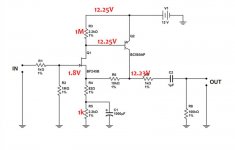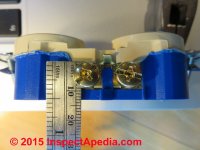When you mentioned an input transformer wired for a 13x voltage gain, I wondered if you'd been thinking of a ribbon mic. It's the only type of mic with such a low output level that you have to treat it like a moving-coil (record player) cartridge.My primary goal with building my own preamp is so i can get better/efficient results with my ribbon mic
One thing about eliminating the preamp altogether is that you have even less noise. The input transformer is virtually noiseless by itself, something you cannot say for a preamp.primary use would be vocals but i thought i could use it for guitar cab micing as well without eliminating the preamp circuit.
Not that it matters when the source is an electric guitar amp, complete with inevitable hum, hiss, string whistle from sliding fingers, thumping noises from fingers coming down on the fretboard, and other nasties living maybe 30 - 40 dB below the main signal level.
(I play guitar, so the above is not said with contempt for the instrument or anything like that - just the awareness that it's not an instrument that produces a great deal of usable dynamic range in practice.)
IMHO, there's nothing wrong with using the right tool for the job. A Swiss Army Knife is very versatile, but I'd rather have a plain ordinary Phillips screwdriver when that's all I actually need.Oh well, cant have everything.
As an aside, here in Canada, we have these wonderful things called Robertson screws - my absolutely favourite screw design, even though I only encountered them for the first time just four years ago. They are like Allen heads, except with a square depression rather than a hexagonal one. That design makes them much stronger - Robertson screw heads never round-out, and they will stay on the tip of the screwdriver so you can reach awkward locations.
So I'd rather have a Robertson screw-driver than a Phillips one.
More on Robertson screws:
1) robertsonscrew
2) 'You've got to use a Robertson' - The Globe and Mail
-Gnobuddy
When you mentioned an input transformer wired for a 13x voltage gain, I wondered if you'd been thinking of a ribbon mic. It's the only type of mic with such a low output level that you have to treat it like a moving-coil (record player) cartridge. -Gnobuddy
Yes that is correct. There is plenty gain for driving my dynamic mics with this preamp and IMHO they sound nicer through this circuit.
One thing about eliminating the preamp altogether is that you have even less noise. The input transformer is virtually noiseless by itself, something you cannot say for a preamp.
Not that it matters when the source is an electric guitar amp, complete with inevitable hum, hiss, string whistle from sliding fingers, thumping noises from fingers coming down on the fretboard, and other nasties living maybe 30 - 40 dB below the main signal level.
(I play guitar, so the above is not said with contempt for the instrument or anything like that - just the awareness that it's not an instrument that produces a great deal of usable dynamic range in practice.)
I agree but i must say i cannot complain in regard to the noise from this circuit. I am "only" hearing noise from the PSU but i think that is my fault for dismantling a cheap 12V wall wart and wirinig it directly in the chassis inside. I hope i would get rid of this with a regulated psu which i would isolate inside with a aluminium wall screwed between psu and the circuit and perhaps a better grounding scheme.
Yes, our guitar amplifiers are noisey beasts but noise performance is not the reason why we like them, right ?
IMHO, there's nothing wrong with using the right tool for the job. A Swiss Army Knife is very versatile, but I'd rather have a plain ordinary Phillips screwdriver when that's all I actually need.
As an aside, here in Canada, we have these wonderful things called Robertson screws - my absolutely favourite screw design, even though I only encountered them for the first time just four years ago. They are like Allen heads, except with a square depression rather than a hexagonal one. That design makes them much stronger - Robertson screw heads never round-out, and they will stay on the tip of the screwdriver so you can reach awkward locations.
So I'd rather have a Robertson screw-driver than a Phillips one.
More on Robertson screws:
1) robertsonscrew
2) 'You've got to use a Robertson' - The Globe and Mail
-Gnobuddy
Never heard of robertson screws, but i will certainly give them a try. Thanks for the tip !
Anyway, i have made further modification to the circuit per your and PRR suggestions and these are my voltages ( Not good i cannot dial 6V on Q2. In fact i cannot dial anything down from 12V on the collector);
Attachments
Did you add any RC filtering to the +12V from the PSU? I've used cheap wall warts for power several times, they whistle loudly (lots of ripple at a high audio frequency) unless you add an RC to filter out the noise.I am "only" hearing noise from the PSU ...a cheap 12V wall wart
Since the frequency is usually at least several kHz (instead of 60 Hz), you can get a lot of filtering without having to use huge resistances or capacitances. For example, 100 ohms and 100 uF should work well.
I never saw one all the years I lived in the USA. They seem to have remained a Canadian secret for over a century.Never heard of robertson screws, but i will certainly give them a try. Thanks for the tip !
There is a story about how the inventor was swindled by a crooked British manufacturer he licensed to manufacture his screws. After that, he vowed never to let control of his design out of his hands, and so turned down deals in America (including one with Henry Ford.)
Just to confirm: R6 is 33k now, and R4 is 270 ohms, correct?...Not good i cannot dial 6V on Q2. In fact i cannot dial anything down from 12V on the collector);
If so, the result you just obtained is actually good: remember, the goal was to increase the current through Q1, allowing you to use a smaller value than 1M for R3. (1M is absurdly large, as we discussed before, it means Q1 is flowing only a fraction of a microamp, which is about a thousand times too little for it to work properly.)
The changes you made have now increased the current through Q1 (yay!) But you have not yet decreased R3 to match. That's why Q2 collector voltage is stuck at 12.25V.
So the trick now is to find out what drain current Q1 is flowing, and pick R3 so it turns on Q2, but only just turns it on - that way, you can dial Q2 collector to 6V with your 5k trimpot (R5).
I'm going to make a guesstimate, based on the voltages you posted, and walking in small circles scratching my head and thinking for a few minutes. Try 680 ohms (not kilo ohms) for R3. I think this will get the circuit close enough to balance that your 5k trimpot (R5) should do the rest.
But lets suppose I guessed wrong. You used 680 ohms for R3, and the collector of Q2 still stubbornly remains above 6 V. This tells you R3 is still too big, so try 560 ohms. If that doesn't do it, try 470 ohms. Et cetera.
Suppose, on the other hand, with R3=680 ohms, the collector of Q2 now sits too low (2.5 V, say), and cannot be raised to 6V with the 5k trimpot R5. This means you need to increase the value of R3 - so try 820 ohms. Still too low? Try 1k.
By now, you are probably cursing under your breath. So am I - all this fussing and fiddling is the result of a marginally designed JFET circuit, which is not tolerant of any significant change in JFET parameters. (It is also a circuit with limited headroom before it clips, as we saw earlier - IMO 12V is far too low a supply voltage for a modern preamp. It's even too low for a modern guitar FX pedal.)
Anyway, I think this will finally give you your happy ending. At the least, you should have your preamp working as you were originally expecting it to work!
I spent today volunteering at a local elementary school (they are putting on a play soon, and I was helping build stage props for the kids to use.) I will be doing the same tomorrow, so I may not be able to check the thread till tomorrow night, Vancouver time.
-Gnobuddy
Yeah, there are a couple of little mistakes on that diagram. But you can figure out what's happening from the text and the history of the thread so far.So how can Q2 fully conduct without any base-emitter voltage?
I bet the base of Q2 is actually near 11.7 or 11.65 volts now, not 12.25V.
-Gnobuddy
OFF topic!!
Many small electrical devices (switches, outlets) sold in the US have a Robertson square hidden in the Phillips/Plain screw heads. The 39-piece screwdriver bit sets often have several Robertsons.{Robertson} I never saw one all the years I lived in the USA. They seem to have remained a Canadian secret for over a century. ....
Attachments
After a long time i can reply as it would seem quite rude to leave without the conclusion.
Unfortunately i had to take a break from this preamp project ( Gnobuddy said it right. I was starting to seriously "curse under my breath") as in the meantime i was switching careers, renovating my work space, living arrangement and basically starting something new.
Anyway, i did not forget this preamp project as i am a very stubborn man so i would, once again, like to share some numbers.
Results from today;
Q2 Emitter 11.70 V
Base 11.70 V
Collector 6.61 V
Q1 Drain 11.70 V
Gate 0.00 V
Source 1.85 V
I hope i tied the pinout names with voltages correct. In regards of Q1, the voltage i was stuck before (0.77V) now i managed to adjust to 1.85 V
Unfortunately i had to take a break from this preamp project ( Gnobuddy said it right. I was starting to seriously "curse under my breath") as in the meantime i was switching careers, renovating my work space, living arrangement and basically starting something new.
Anyway, i did not forget this preamp project as i am a very stubborn man so i would, once again, like to share some numbers.
Results from today;
Q2 Emitter 11.70 V
Base 11.70 V
Collector 6.61 V
Q1 Drain 11.70 V
Gate 0.00 V
Source 1.85 V
I hope i tied the pinout names with voltages correct. In regards of Q1, the voltage i was stuck before (0.77V) now i managed to adjust to 1.85 V
That sounds good! Glad you finally got it working properly!Q2...Collector 6.61 V
-Gnobuddy
The last post on page 1 is from twelve years ago!Oops, just noticed that this thread does not stop on page 1...
-Gnobuddy
- Status
- This old topic is closed. If you want to reopen this topic, contact a moderator using the "Report Post" button.
- Home
- Live Sound
- Instruments and Amps
- Hamptone JFET mic pre help!

